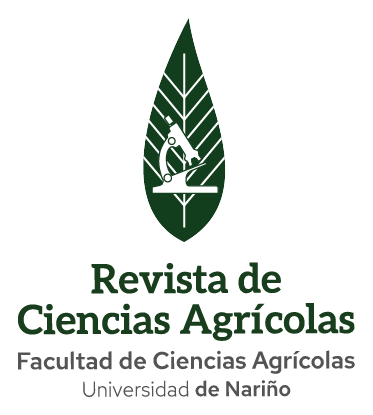ANÁLISIS DE ALGUNOS ASPECTOS AGROECONÓMICOS DEL CULTIVO DE LULO (Solanum quitoense L.)
Abstract
Dada la escasa información existente en el departamento de Nariño, sobre aspectos agroeconómicos del cultivo de lulo, este trabajo da a conocer los más relevantes, como la siembra, prácticas culturales, poda, fertilización, control de malezas, control de plagas y enfermedades, utilización de mano de obra, rendimientos, inversión, costos de producción y aspectos de la comercialización.
El presente trabajo se llevó a cabo en el municipio de San Lorenzo, departamento de Nariño, en el segundo semestre del año 2000 y está ubicado en la cuenca hidrográfica de los ríos Mayo y Juanambú, con una temperatura promedio de 17°C y una altitud de 1748 msnm. La información primaria se obtuvo mediante la realización de encuestas distribuidas en las 12 Veredas del municipio, donde se utilizó el método de análisis de correspondencias múltiples y de componentes en donde se determinó la incidencia de cada variable.
Los aspectos más relevantes del estudio son los costos de producción qué totalizan $4.918.982, de los cuales el 67.6% son costos directos, el 34,5% costos indirectos y el 6,9% otros costos, así mismo se estableció que los ingresos brutos fueron $9.983.200 por hectárea.
El flujo geográfico de la producción tiene como destino la central de abastos del Valle del Cauca en un 85%, el mercado central de Pasto con 6,7% y el mercado central de Popayán registra el 5,3%, y el 3% restante como autoconsumo.
ABSTRACT
This work leads the knowledge of the most relevant agroeconomic aspects about lido (Solanum quitoense) culture such as: sowing, cultural practices, pruning, fertilizer, weeds control, pets insects and diseases, hand work, yields, investment, production costs and marketing aspects.
The present study was carried out in the municipality of San Lorenzo, Nariño Department, Colombia, in the second semester of the 2000 year, located in the hydrographic basin of the rivers Mayo and Juanambu, with an average temperature of 17 C and an altitude of 1748 m.a.s.l. The primary information was obtained by means of surveys distributed in 12 Paths of the municipality, The effect of every variable was analyzed using the method of multiple correspondences analysis.
The most relevant aspects of the study are: the production costs, that totalize $ 4.918.982, of which 67,6 % is direct costs, 34,5 % indirect costs and 6,9 % other costs, likewise, it was found that the brute income was $ 9.983.21)0/ hectare. The geographical production flow of the production takes as destiny the supplies center of the Cauca Valley in 85 %, the central market of Pasto with 6,7 % and the central market of Popayan 5,3 %, and 3 % remaining as self-consumption.



























